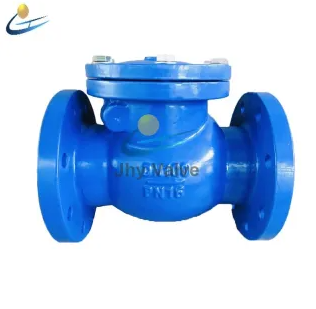Swing Check Valve vs. Check Valve
Valves are essential components of any piping system as they regulate the flow of fluids and gases. They come in various types, each designed for a specific purpose. Two common types of valves are the swing check valve and the check valve. In this article, we will explore the differences between these two valves and help you determine which one is best for your application.

Check Valve
A check valve is a valve that allows fluid or gas to flow in only one direction. It has a closure element that opens and closes automatically in response to the pressure of the fluid or gas passing through the valve. When the fluid or gas flows in the correct direction, the closure element opens, allowing the fluid or gas to pass through the valve. When the fluid or gas tries to flow in the opposite direction, the closure element closes, preventing backflow.
Check valves are commonly used in applications where backflow prevention is critical, such as in sewage systems, irrigation systems, and gas pipelines. They are also used in industries that deal with hazardous materials, such as the chemical and petrochemical industries.
Swing Check Valve
A swing check valve is a type of valve that allows fluid or gas to flow in only one direction. It has a disc-shaped closure element that swings open and closed in response to the pressure of the fluid or gas passing through the valve. When the fluid or gas flows in the correct direction, the disc swings open, allowing the fluid or gas to pass through the valve. When the fluid or gas tries to flow in the opposite direction, the disc swings shut, preventing backflow.
Swing check valves are typically used in applications where low flow resistance is desired, such as in HVAC systems, water treatment plants, and fire protection systems. They are also commonly used in pipelines that carry slurries, which can cause damage to other types of valves.
Swing Check Valve vs. Check Valve
Both swing check valves and check valves are designed to prevent backflow, but they operate differently. Swing check valves use a swinging disc to block backflow, while check valves use an automatic closure element. Swing check valves are typically used in low-flow applications, while check valves are used in high-flow applications.
Another key difference between swing check valves and check valves is their pressure drop. Swing check valves have a lower pressure drop than check valves, which means that they cause less resistance to fluid or gas flow. This makes them a good choice for applications where flow resistance is a concern. Check valves, on the other hand, have a higher pressure drop, which means that they cause more resistance to fluid or gas flow. This makes them a good choice for applications where backflow prevention is critical.
Which One Should You Choose?
The choice between a swing check valve and a check valve depends on your specific application. If you are dealing with hazardous materials or need to prevent backflow in a high-flow application, a check valve is the best choice. If you are dealing with low-flow applications and want to minimize flow resistance, a swing check valve is the way to go.
In conclusion, both swing check valves and check valves are important components of a piping system. Choosing the right valve for your application requires careful consideration of your specific needs and requirements. By understanding the differences between these two valves, you can make an informed decision and ensure that your piping system operates efficiently and safely.

评论
发表评论